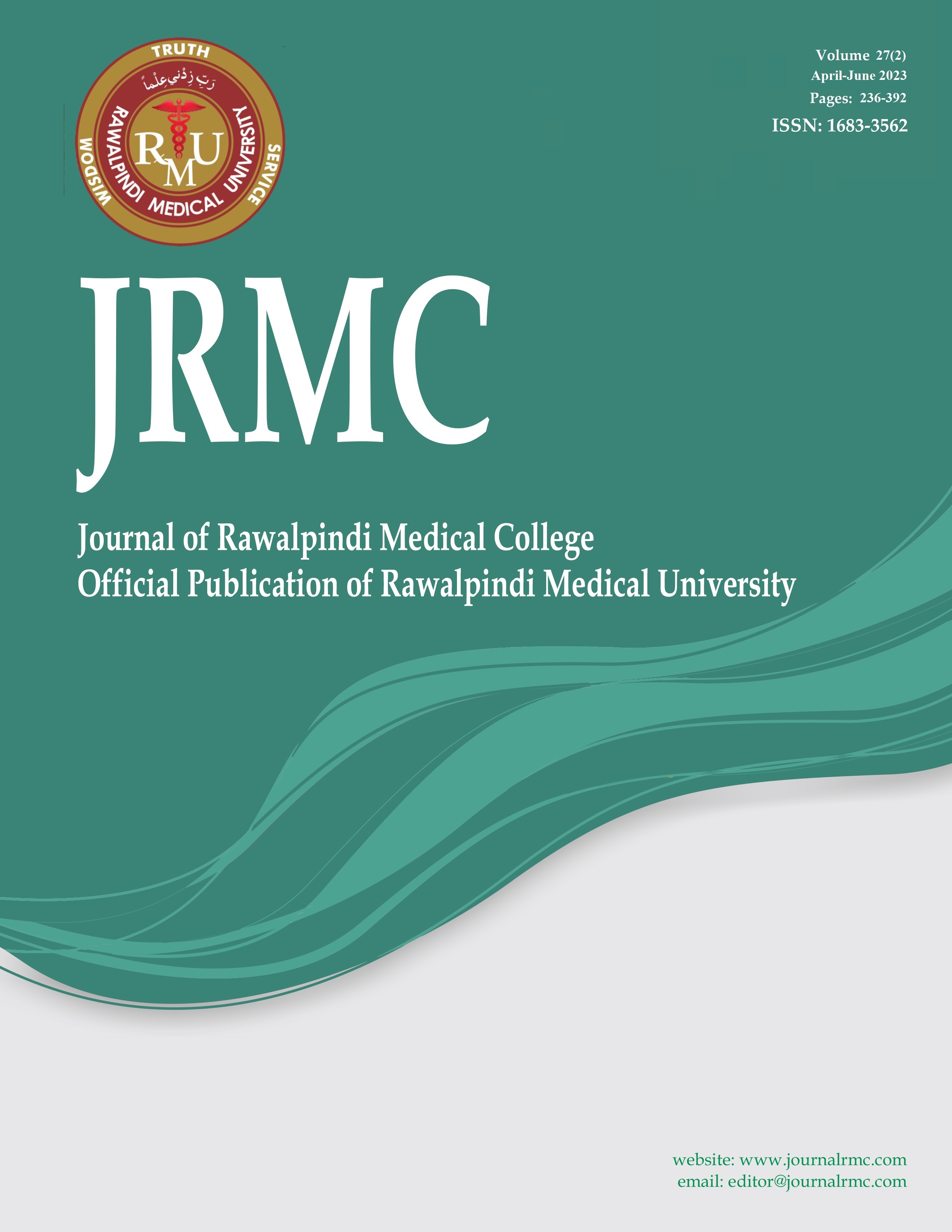Abstract
Objective: To determine the frequency of PIH amongst elevated beta-hCG levels and non-elevated beta-hCG in the mid-trimester of pregnancy.
Materials and Methods: It was Descriptive case series conducted for six months (02-12-2019 to 02-06-2020) in OPD of Gynae Unit-II, Holy Family Hospital, Rawalpindi. A total of one hundred and twenty-two (n=122) normotensive pregnant females at 13-20 weeks gestational age and 18-35 years of maternal age were selected in this study after informed consent from every patient. The frequency of PIH in patients with elevated serum beta-hCG was measured. Data were analyzed using SPSS version 20. Effect modifiers were controlled by stratification. A p-value of ≤ 0.05 was considered significant.
Results: Mean beta-hCG levels in the total study population were found to be 7305.09±3900.64 IU/mL. Median b-hCG levels in our study population were noted as 6936.15 IU/mL. Pregnancy-induced hypertension was found positive in 16 (13.1%) patients. Raised beta-hCG levels were present in 10 (8.2%) patients. The frequency of PIH in raised beta-HCG levels was found in 7/10 (70%) of patients. We found a statistically significant (p-value ≤ 0.05) difference in the frequency of PIH among patients with elevated and not-elevated beta-hCG levels.
Conclusion: It is evident from my study that patients with raised levels of serum β-hCG during mid-trimester pregnancy are at increased risk to develop hypertensive disorders of pregnancy. We further elaborated that there is a statistically significant difference in various effect modifiers such as maternal age, gestational age, residential status, and BMI for developing PIH among patients with elevated and non-elevated beta-hCG levels.
References
Upadya M, Rao ST. Hypertensive disorders in pregnancy. Indian J Anaesth. 2018;62:675–81.
Mehta B, Kumar V, Chawla S, Sachdeva S, Mohapatra D. Hypertension in Pregnancy: A Community-Based Study. Indian J Community Med. 2015;40:273–8.
Aronow WS. Hypertensive disorders in pregnancy. Ann Transl Med. 2017;5:266-7.
Sajith M, Nimbargi V, Modi A, Sumariya R, Pawar A. Incidence of pregnancy-induced hypertension and prescription pattern of antihypertensive drugs in pregnancy. Int J Pharm Sci Res. 2014;5:163-70.
Magee LA, Sharma S, Nathan HL, Adetoro OO, Bellad MB, Goudar S, et al. The incidence of pregnancy hypertension in India, Pakistan, Mozambique, and Nigeria: A prospective population-level analysis. PLoS Med. 2019;16:e1002783.
Muti M, Tshimanga M, Notion GT, Bangure D, Chonzi P. Prevalence of pregnancy-induced hypertension and pregnancy outcomes among women seeking maternity services in Harare, Zimbabwe. BMC Cardiovasc Disord. 2015;15:111-3.
Kour G, Kour S. Serum βhCG levels between 13-20 weeks gestation can predict the development of pregnancy-induced hypertension. NJOG. 2018;24:12-4.
Munirah M, Khalidah MB, Dian Nasriana N, Hanita O, Nor Azlin M. Early Second Trimester hCG of Maternal Serum as Predictor Marker for Pregnancy Induced Hypertension. Med & Health. 2018;13:143-52.
Sharma V, Sharma P, Firdous N. BETA HCG in Mid Trimester as a Predictor of Pregnancy Induced Hypertension. Int J Sci Res. 2016;5:303-5.
Chowdhary H, Khurshid R, Parveen S, Yousuf S, Tali SH, Shah ZA. Utility of second-trimester beta HCG levels in the prediction of gestational hypertension: a prospective cohort study. Int J Reprod Contracept Obstet Gynecol. 2017;6:1040-4.
Ravankar VM, Narmada L. Assessment of serum βhCG and lipid profile in the early second trimester as predictors of hypertensive disorders of pregnancy. Int J Gynaecol Obstet. 2017;138:331-4.
Vanitha V, Shanthi S, Rani SU. To Study the Role of Maternal Serum Beta hCG at 13–20 Weeks of Gestation in Prediction of Pre-Eclampsia. Obstet Gynaecol. 2016;5:39-41.
Gestational Hypertension and Preeclampsia: ACOG Practice Bulletin Summary, Number 222. Obstet Gynecol. 2020;135:1492-1505.
. Brown MA, Magee LA, Kenny LC. Hypertensive Disorders of Pregnancy: ISSHP Classification, Diagnosis, and Management Recommendations for International Practice. Hypertension. 2018;72:24-30.
Sisti G, Colombi I. New blood pressure cut off for preeclampsia definition: 130/80 mmHg. Eur J Obstet Gynecol Reprod Biol. 2019;240:322-30.
Payne B, Magee LA, von Dadelszen P. Assessment, surveillance and prognosis in pre-eclampsia. Best Pract Res Clin Obstet Gynaecol. 2011;25:449-55.
Magee LA, Pels A, Helewa M. Diagnosis, evaluation, and management of the hypertensive disorders of pregnancy: executive summary. J Obstet Gynaecol Can. 2014;36:416-25.
Tranquilli AL, Dekker G, Magee L. The classification, diagnosis and management of the hypertensive disorders of pregnancy: A revised statement from the ISSHP. Pregnancy Hypertens. 2014;4:97-106.
Sibai BM. Diagnosis, controversies, and management of the syndrome of hemolysis, elevated liver enzymes, and low platelet count. Obstet Gynecol. 2004;103:981-90.
Abalos E, Cuesta C, Grosso AL. Global and regional estimates of preeclampsia and eclampsia: a systematic review. Eur J Obstet Gynecol Reprod Biol. 2013;170:1-9.
Lisonkova S, Sabr Y, Mayer C. Maternal morbidity associated with early-onset and late-onset preeclampsia. Obstet Gynecol. 2014;124:771-80.
Duckitt K, Harrington D. Risk factors for pre-eclampsia at antenatal booking: a systematic review of controlled studies. BMJ. 2005;330:565-75.
Bartsch E, Medcalf KE, Park AL. Clinical risk factors for pre-eclampsia determined in early pregnancy: systematic review and meta-analysis of large cohort studies. BMJ. 2016;353:i1753-65.
van Rijn BB, Hoeks LB, Bots ML. Outcomes of subsequent pregnancy after a first pregnancy with early-onset preeclampsia. Am J Obstet Gynecol. 2006;195:723-30.
Gaugler-Senden IP, Berends AL, de Groot CJ, Steegers EA. Severe, very early onset preeclampsia: subsequent pregnancies and future parental cardiovascular health. Eur J Obstet Gynecol Reprod Biol. 2008;140:171-80.

This work is licensed under a Creative Commons Attribution-ShareAlike 4.0 International License.





